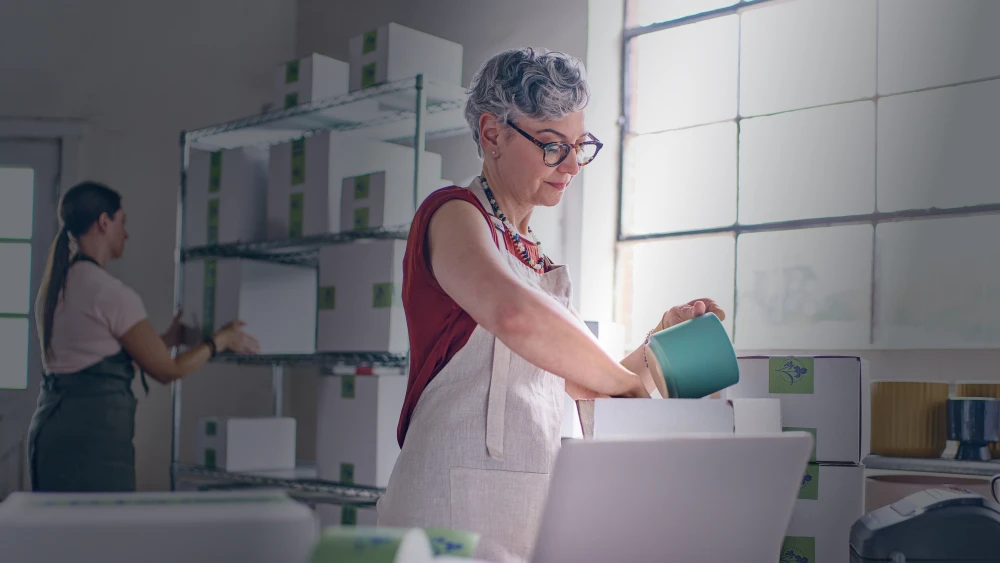The Peak season from October to January is a big deal for your business. With more orders coming in, your shipping operations are really put to the test. Logistics networks everywhere feel the strain, and you know your customers have high expectations for on-time deliveries, especially during the holidays. Getting your preparation right isn’t just about keeping up; it’s about standing out.
Great packaging is your first line of defense. For your customer, it’s the first physical touchpoint with your brand after they’ve clicked ‘buy’. It protects your products, represents your brand, and helps ensure a smooth journey through the delivery network. Let’s dive into five tips to help get your packages ready for a successful Peak 2025.
1. Choose the right foundation
Think of your packaging as the foundation of a great delivery experience. Choosing the right size and type of container is a great place to start. We recommend using a high-quality, six-sided corrugated cardboard box for your parcels. This shape moves predictably through automated sorting systems, reducing the chance of a jam. If you’re shipping fragile or heavy items, consider using a double-wall box for extra strength.
It’s important that your packaging is the right size for the item inside. A box that’s too big not only wastes material but allows items to shift around, increasing the risk of damage. A box that’s too small can burst under pressure. For smaller, non-fragile items, a padded envelope or polybag can be a great option. Don’t forget to check your shipping provider’s size and weight restrictions. With Amazon Shipping in the US, your package must be under 50lb and within the dimensions of 59” (L) x 33” (W) x 33” (H).
2. Secure your items inside
Once you’ve picked your outer packaging, it’s time to secure what’s inside. Good cushioning stops your products from moving around, which is key to preventing damage during transit. It’s always a good idea to wrap items individually, especially if they’re fragile. Use enough dunnage, or cushioning material like bubble wrap or kraft paper, to fill any empty spaces in the parcel. A gentle shake of the box should tell you if it’s packed tightly enough; you shouldn’t hear or feel anything moving.
Some items need a little extra care. For liquids, use a leakproof inner liner as well as a leakproof outer box to prevent spills, and make sure your items adhere to our dangerous goods policy. For items with sharp edges or points, wrap them in heavy cardboard to ensure they don’t pierce the packaging.
3. Seal it with confidence
A strong seal keeps your products secure inside the box until they reach your customer. Use a strong, pressure-sensitive tape to seal your parcel. For the most secure seal, we recommend using the H-taping method. First, apply one strip of tape along the center seam of the box. Then, apply two more strips of tape across both edge seams. Repeat this on the top and bottom of the box. This method reinforces all the main stress points.
Just a heads-up, Amazon Shipping restricts the use of plastic strapping or banding. This material can get caught in our automated sorting machinery, which can damage the equipment or your package.
4. Get the label right
Getting the label right is critical for a fast and efficient journey. Our automated sorting facilities scan thousands of packages an hour, and they are sensitive to label quality and placement. An incorrect, damaged, or hard-to-read label is one of the most common reasons for delays, as it requires manual intervention.
Here’s a quick checklist to make sure your labels are ready for scanning:
- Place it on a flat surface. The label should be on the largest, flattest side of the package. Don’t fold it over an edge or curve, as this can make the barcode unreadable.
- Ensure it is clear. The barcode should be printed crisply and should not be faded, creased, or obscured. If you reuse a box, make sure to completely remove or cover any old shipping labels to avoid confusion.
- Keep it uncovered. Don’t place tape or plastic over the label, as reflections can interfere with scanning.
5. Prepare for pickup
If you’re a business with larger daily volumes, palletizing your packages can be a real time-saver in the warehouse. A well-built pallet allows our drivers to load your shipment quickly and get it into our network faster. To make sure the handover is smooth, it’s important to build your pallets correctly. Use standard-sized wooden pallets and stack the heavier items on the bottom in an interlocking pattern for stability. The total height of the stacked pallet should not be higher than 77 inches, and it can’t weigh more than 2000 lb. Finally, wrap the pallet securely at least three times with clear shrink wrap.
Following these packaging tips does more than just protect your products. It helps create the kind of positive experience that turns a first-time buyer into a loyal fan. A secure, well-presented package shows you care, building customer trust from the moment it arrives at their door. During the busy Peak season, getting that moment right is more important than ever, and we’re here to help you deliver for your customers.
Want more details?
For a complete overview of our requirements and more helpful visuals, be sure to check out our detailed guides.

